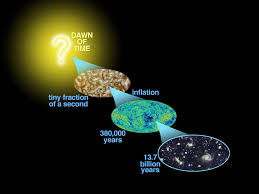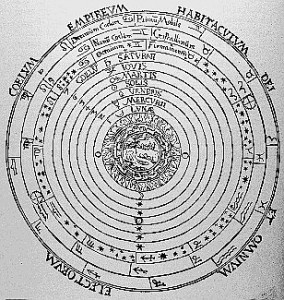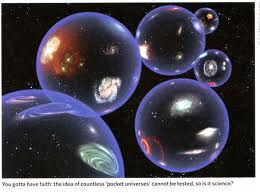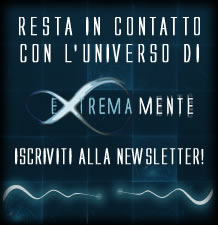L’annuncio di qualche giorno fa della scoperta della prima prova diretta dell’inflazione cosmica, cioè della teoria formulata alla fine degli anni Settanta per spiegare ciò che accadde appena dopo il Big Bang, ha una conseguenza importante. La registrazione delle onde gravitazionali primordiali emesse nei primissimi istanti di vita dell’universo confermerebbe infatti anche un’altra ipotesi, ovvero l’esistenza del multiverso. In sostanza, dicono gli scienziati, quello in cui noi ci troviamo sarebbe solo uno degli universi possibili.
Secondo gli astrofisici, quando il cosmo si è formato, in quella infinitesimale frazione di secondo dopo la grande esplosione di circa 13,8 miliardi di anni fa, alcune parti dello spazio-tempo si sarebbero espanse più rapidamente di altre, molto di più della velocità della luce. Ciò avrebbe creato delle bolle che poi diedero vita ad infiniti universi. Ma mentre il nostro segue le leggi della fisica che nei secoli abbiamo individuato, gli altri ne avrebbero di completamente diverse.
“È molto difficile costruire modelli di inflazione cosmica che non portino ad un multiverso”, ha detto ad esempio il fisico teoretico Alan Guth, commentando il risultato raggiunto dal team di ricercatori guidati da John Novac, dell’Harvard-Smithsonian Center for Astrophisics di Cambridge. “Non è del tutto impossibile, quindi ritengo che si debba ancora indagare in merito, ma la prova dell’inflazione ci spinge a prendere seriamente in considerazione l’idea del multiverso.” Un’idea che sembra il risultato delle scoperte della scienza attuale e invece- a quanto pare- ha radici molto antiche.
È quanto affermano i fisici dell’Università di Durham, in Gran Bretagna, dopo aver tradotto in moderne equazioni il pensiero di un teologo vissuto nel XIII secolo: quel testo medioevale sembra anticipare concetti assai prossimi a quello del multiverso. Il pensatore è Roberto Grossatesta, vescovo di Lincoln, considerato il vero fondatore del pensiero scientifico di Oxford. L’opera presa in esame è il trattato “De Luce”.
“Abbiamo cercato di riscrivere in termini matematici quello che lui aveva scritto in latino”, ha detto Tom McLeish, a capo del gruppo di ricerca. ”Quando hai delle equazioni, puoi metterle in un computer e risolverle. Stiamo esplorando matematicamente un nuovo tipo di universo, cosa che i teorici delle stringhe fanno continuamente. Noi siamo semplicemente teorici delle stringhe medioevali.”
Grossatesta si era ispirato al lavoro di Aristotele e il filofoso greco spiegava il movimento dei pianeti e delle stelle collocando la Terra al centro di sfere celesti concentriche, approfondendo la concezione geocentrica di Eudosso. Nel suo trattato, il teologo inglese proponeva che quell’universo avesse avuto inizio con un lampo di luce che aveva spinto ogni elemento verso l’esterno, a partire da un iniziale, piccolo punto centrale fino ad una grande sfera: praticamente, un Big Bang ante litteram.
Il pensatore cristiano presupponeva che luce e materia fossero accoppiate. Quando l’impulso iniziale di espansione della luce-materia raggiunse la densità minima, entrò in quello che egli definiva uno stato di perfezione e smise di espandersi. Questa sfera perfetta allora emetteva un tipo differente di luce definita lumen, che si propagava all’interno e investiva la residuale materia imperfetta, comprimendola.
La regione meno densa di luce-materia rimasta allora poteva raggiungere il suo stato di perfezione e cristallizzarsi in una nuova sfera inglobata nell’altra. A sua volta, essa avrebbe emesso il suo lumen e il processo sarebbe ricominciato, fino a quando non fosse rimasto un nucleo di materia imperfetta dal quale poi si sarebbe generata la Terra.
Trasformando tutto in numeri, la squadra di McLeish ha trovato che i modelli al computer di questo processo producono esattamente l’universo descritto da Roberto Grossatesta, ovvero un universo che si propaga per sfere concentriche. Un concetto analogo al modo nel quale gli scienziati di oggi usano le osservazioni della radiazione cosmica di fondo– residuo dell’originale Big Bang- per dimostrare i modelli matematici del moderno universo, incluso quel periodo di rapidissima espansione detto, per l’appunto, inflazione.
“L’articolo formula il modello di Grossatesta in termini di equazioni differenziali che possono essere risolte con le tecniche di calcolo attuali”, ha confermato il cosmologo Avi Loeb, collega di Novac all’Harvard-Smithsonian Center for Astrophisics. All’insaputa del teologo inglese del XIII secolo, però, la sua idea di universo includeva anche la possibilità del multiverso.
I nostri modelli interpretativi valgono infatti solo se determinati parametri mantengono un determinato valore. Sarebbe bastata, ad esempio, una minima variazione nelle forze che agiscono sulla materia e l’universo non sarebbe come appare oggi. Gli studiosi lo definiscono un problema di messa a punto e un modo per risolverlo è ammettere l’esistenza di infiniti universi, nei quali si possono verificare infinite combinazioni: noi viviamo in questo solo perchè è risultato adatto allo sviluppo della vita.
Ma anche il risultato finale di Grossatesta dipende dal suo stato iniziale: se fosse cambiato il modo nel quale luce e materia erano accoppiate, si sarebbe ottenuto anche un numero diverso di sfere celesti. “Ovviamente, l’autore medioevale non si era reso conto che così potevano esserci molti multiversi”, aggiunge McLeish. “Tuttavia, cosa penseranno gli uomini del futuro, tra 800 anni, delle congetture che adesso stiamo facendo noi? Ci vuole un po’ di umiltà, considerando quello che riusciamo a vedere e quello che ancora ci sfugge.”
Una posizione condivisa da Loeb. “Un giorno, le future generazioni di astrofisici avranno una migliore comprensione dell’inflazione e potranno considerare il modo nel quale oggi interpretiamo il cosmo più o meno come noi, adesso, giudichiamo la visione di Grossatesta. Abbiamo fatto molti progressi a partire dal XIII secolo, ma abbiamo ancora una lunga strada da percorrere.”
SABRINA PIERAGOSTINI
Like the cosmos littered with stars, the dark ages were sprinkled with beacons of scientific light.
When physicists translated a 13th-century Latin text into modern equations, they discovered that the English theologian who wrote it had unwittingly predicted the idea of the multiverse in 1225. While the work probably won’t advance current models, it does show that some of the philosophical conundrums posed by cosmology are surprisingly pervasive.
Tom McLeish, a physicist at Durham University, UK, and his colleagues applied modern mathematics to a 1225 treatise on light, De luce, written by medieval philosopher Robert Grosseteste.
“We tried to write down in maths what he’s said in Latin words,” says McLeish. “Then you have a set of equations, which you can then go about putting it in the computer and solving. We’re mathematically exploring a new type of universe, which is what string theorists do all the time. We’re just medieval string theorists.”
Grosseteste had been studying the recently rediscovered works of Aristotle, which explained the motion of the stars by embedding Earth in a series of nine concentric celestial spheres. In De luce, Grosseteste proposed that the concentric universe began with a flash of light, which pushed everything outwards from a tiny point into a big sphere.
Celestial spheres
Grosseteste assumed that light and matter are coupled together. When the initial pulse of expanding light-matter reached a minimum density, it entered what he called a perfect state and stopped expanding. This perfect sphere then emitted a different form of light called lumen, which propagated inwards and swept up lingering “imperfect” matter, compressing it like a snow plough. The less dense region of light-matter left behind could then reach its perfect state and crystallise into a new sphere embedded in the first one, which would emit its own lumen. This process continued until only a core of imperfect matter was left behind, which gave rise to Earth.
Crunching the numbers, McLeish’s team found that computer models of this process will yield exactly the sort of universe Grosseteste was describing: inwardly propagating concentric spheres. This is analogous to the way modern cosmologists use observations of the cosmic microwave background, relic radiation from the big bang, to test out mathematical models of the modern universe, including a predicted period of rapid expansion called inflation.
“The paper formulated the Grosseteste model in terms of differential equations that can be solved with modern numerical techniques,” says cosmologist Avi Loeb at the Harvard-Smithsonian Center for Astrophysics in Cambridge, who was not involved in the work. “As such, the model is well defined.”
Cosmic humility
And unbeknown to Grosseteste, his universe predicts one of the most puzzling possibilities of big bang cosmology: the multiverse. Current models agree with observations only if certain parameters take particular values – if the forces holding matter together were stronger or weaker, for instance, the universe would not look the way it does.
Scientists call this the fine-tuning problem, and one way to solve it is to say there must be an infinite number of universes in which all outcomes are possible. We live in this one because it happens to be well-suited for life. The outcome of Grosseteste’s model depends similarly on its initial state. Change the way light and matter couple together, and you can get a different number of spheres.
“Obviously he didn’t realise that there could be many multiverses,” says McLeish. “But what will people in 800 years’ time be thinking about the assumptions we’re making? There’s a bit of humility in realising that we’re constrained by what we can see and what we can’t.”
Loeb agrees that the results echo some of the philosophical trademarks of modern cosmology. “Once future generations of cosmologists have a better understanding of inflation, they might look at our current world view in much the same way we look at Grosseteste’s worldview. We have made a lot of progress since the 13th century, but we still have a long way to go.”
ççççççççççççççç
The first direct evidence of cosmic inflation — a period of rapid expansion that occurred a fraction of a second after the Big Bang — also supports the idea that our universe is just one of many out there, some researchers say.
On Monday (March 17), scientists announced new findings that mark the first-ever direct evidence of primordial gravitational waves — ripples in space-time created just after the universe began. If the results are confirmed, they would provide smoking-gun evidence that space-time expanded at many times the speed of light just after the Big Bang 13.8 billion years ago.
The new research also lends credence to the idea of a multiverse. This theory posits that, when the universe grew exponentially in the first tiny fraction of a second after the Big Bang, some parts of space-time expanded more quickly than others. This could have created “bubbles” of space-time that then developed into other universes. The known universe has its own laws of physics, while other universes could have different laws, according to the multiverse concept.
Inflation is the mysterious force that blew up the scale of the infant universe from sub-microscopic to gargantuan in a fraction of a second. See how cosmic inflation theory for the Big Bang and universe’s expansion works in this Space.com infographic.
Credit: By Karl Tate, Infographics ArtistView full size image”It’s hard to build models of inflation that don’t lead to a multiverse,” Alan Guth, an MIT theoretical physicist unaffiliated with the new study, said during a news conference Monday. “It’s not impossible, so I think there’s still certainly research that needs to be done. But most models of inflation do lead to a multiverse, and evidence for inflation will be pushing us in the direction of taking [the idea of a] multiverse seriously.”
Other researchers agreed on the link between inflation and the multiverse.
“In most of the models of inflation, if inflation is there, then the multiverse is there,” Stanford University theoretical physicist Andrei Linde, who wasn’t involved in the new study, said at the same news conference. “It’s possible to invent models of inflation that do not allow [a] multiverse, but it’s difficult. Every experiment that brings better credence to inflationary theory brings us much closer to hints that the multiverse is real.”
When Guth and his colleagues thought up cosmic inflation more than 30 years ago, scientists thought it was untestable. Today, however, researchers are able to study light left over from the Big Bang called cosmic microwave background radiation (CMB).
In the new study, a team led by John Kovac of the Harvard-Smithsonian Center for Astrophysics found telltale signs of inflation in the microwave background. The researchers discovered a distinct curl in the polarization pattern of the CMB, a sign of gravitational waves created by the rapid expansion of space-time just after the Big Bang.
If multiple universes exist, they may collide with each other and leave behind signs in the cosmic microwave background radiation, researchers say.
Credit: Stephen Feeney/UCLView full size imageLinde, one of the main contributers to inflation theory, says that if the known universe is just one bubble, there must be many other bubbles in the cosmic fabric.
“Think about some unstable state,” Linde explained. “You are standing on a hill, and you can fall in this direction, you can fall in that direction, and if you’re drunk, eventually you must fall. Inflation is instability of our space with respect to its expansion.
“You have something growing exponentially,” he added. “If you just let it go … it will continue exponentially growing, so this [the known universe] is one possibility of something going wrong with this instability, which is very, very right for us because it has created all of our space. Now, we know that if anything can go wrong, it will go wrong once and a second time and a third time and into infinity as long as it can go.”








Pingback: L’inflazione cosmica e il multiverso | Pianetablunews
antI litteram?? 😉 Questo correttore di bozze… 😀
sempre peggio… ora licenzio!
😀
I matematici hanno rovinato la fisica con congetture che sono in realtà dimostrazioni per assurdo, di ciò che non può esistere perché non è costruibile. Poi le chiamano paradossi e provano a dimostrarle vere. Queste congetture sono invece antinomie, ovvero contraddizioni irrisolvibili. I paradossi sono invece sistemi matematici con assioma diversi ma coerenti ciascuno nel proprio sistema. Pertanto i paradossi non sono assurdità non costruibili in assoluto, ma sono modelli separati e disgiunti tra loro, che non si contraddicono affatto, essendo tutti costruiti con numeri immaginari in sistema separati. Infatti esistono diverse geometrie e diverse matematiche tutte coerenti a se stanti e quindi non contraddittorie Tra loro, perché sono tutte solo ipotesi immaginarie.
Nessuna di loro è il vero modello della vera realtà dell’ESSERE MENTALE.
Non esistono quindi buchi neri, multi versi, stelle esotiche che superino il principio di esclusione di Pauli e lo stato di plasma degenere, non esiste il bosone di Higgs e non sono possibili i viaggi nel tempo.
La fisica della relatività è matematica travisata in eventi materiali, che dimostra invece per assurdo, proprio tutto ciò che la materia non può fare, (raggiungere o addirittura superare la velocità dell’informazione luminosa, contrarsi all’infinito e simili panzane). Certo coi numeri si può fare anche ciò che la scienza e l’osservazione negano possibile. Le super nove esplodono, le stelle di neutroni dissipano l’energia gravitale in velocità di rotazione e calore, ma i matematici aggiungono gravità contro le evidenze e s’inventano singolarità inesistenti e impossibili.
Le loro sono invece dimostrazioni per assurdo proprio di ciò che non può accadere alla materia.
Vincenzo RUSSO iltachione@alice.it ; http://www.webalice.it/iltachione .